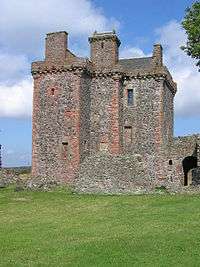Balvaird Castle
Balvaird Castle (also spelled as Balverd Castle or Balverde Castle or Balwaird Castle[1] or Baleward Castle[2]) in Perthshire is a particularly fine and complete example of a traditional late medieval Scottish tower house. It is located in the Ochil Hills, around 5 kilometres (3.1 mi) south of Abernethy. The name Balvaird is from Baile a' Bhàird, 'Township of the Bard' in Gaelic. Balvaird Castle is a scheduled monument, and is in the care of Historic Environment Scotland.[3]


Origins
Balvaird was built around the year 1500 for Sir Andrew Murray, a younger son of the family of Murray of Tullibardine. He acquired the lands of Balvaird through marriage to the heiress Margaret Barclay, a member of a wealthy family. It is likely that Balvaird Castle was built on the site of an earlier Barclay family castle. Substantial remnants of earthwork fortifications around the Castle may survive from earlier defences.[4]
Additions and later history
Over the years the castle was extended and altered. A gatehouse was built in 1567. An outer courtyard was attached to the main gate which possibly contained stabling as well as adding an extra layer of defence to the castle. Another courtyard to the south was a garden, while a much larger walled area to the north-east was an orchard or 'pleasance.'
The family continued to live at Balvaird until they were elevated to the Viscountcy of Stormont (ancestors of the Earldom of Mansfield) and in 1658 moved to the rather more comfortable Scone Palace, near Perth. Thereafter the castle continued to be inhabited, though not by the family itself. In its later days, it probably accommodated farm workers.
The Castle was restored and partially excavated in recent years by Historic Scotland, by whom it is maintained, although it was owned by the Murray family until 2017. The site is open at all times, but the tower-house itself can only be visited on a restricted number of days every year. Balvaird Castle is the caput of the feudal Lordship and Barony of Balvaird and is currently owned by American entrepreneur, Brady Brim-DeForest. [5]
Architecture
Balvaird is notable among Scottish castles of its date for its refined architectural detail. Features include corbels in the form of carved heads supporting the corner-roundels of the wall-walk, an unusually elaborate aumbry (wall-cupboard) in the first-floor hall and a cap-house above the stair in the form of a miniature tower-house. It has been suggested that some or all of these carved stone features may have been brought to Balvaird for re-use from an ecclesiastical building.
References
- Registrum Magni Sigilli Regum Scotorum: The Register of the Great Seal of Scotland, Vol 4, 1886, p. 1045
- The Building, Vol 78, Builder House, 1900, p. 373
- Historic Environment Scotland. "Balvaird Castle (SM90027)". Retrieved 15 February 2019.
- Peter Chalmers (1859). Historical and Statistical Account of Dunfermline. W. Blackwood and sons.
- Registers of Scotland Collection Point, archived from the original on December 1, 2017
- Lewis, John (1992). "Excavations at Balvaird Castle" (PDF). Proceedings of the Society of Antiquaries of Scotland. 122: 365–382.
External links
| Wikimedia Commons has media related to Balvaird Castle. |
- Balvaird Castle - Dark Isle
- Balvaird Castle - Hilltop Lookout - Scotland.com